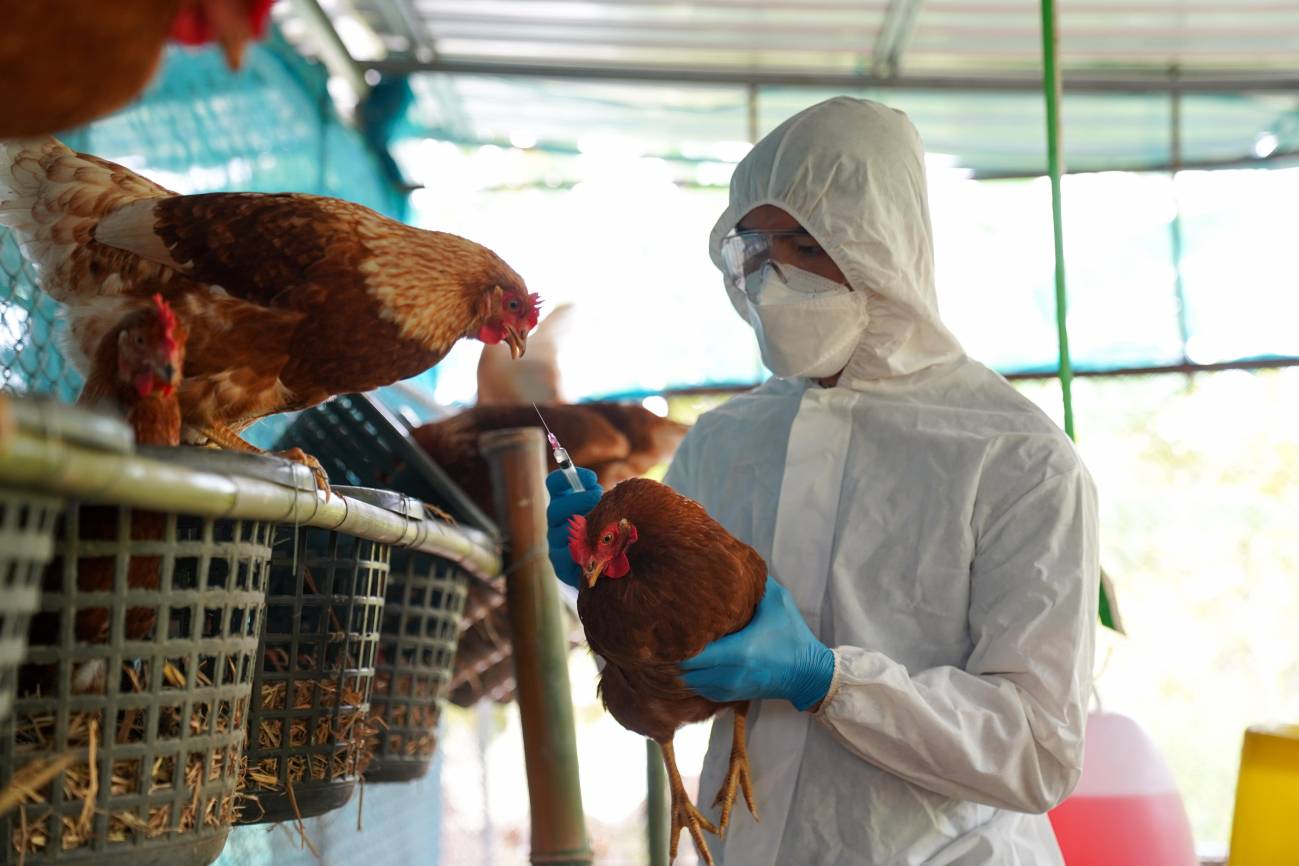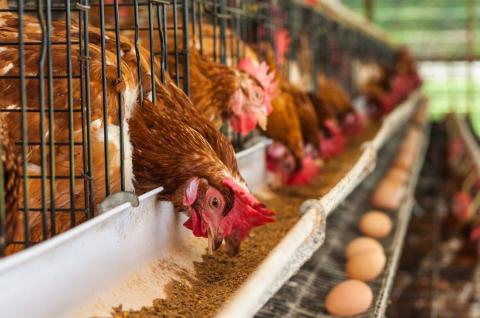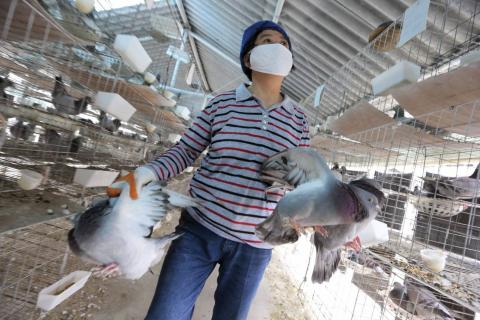Reactions: a protein is identified that prevents transmission and replication of avian influenza viruses in humans
Although outbreaks of H5N1 avian influenza have reached record numbers in recent years, human infections remain anecdotal. A study published today in Nature identifies a protein responsible for inhibiting the replication of this virus in humans, while 'human' flus are able to evade it. The authors propose that this protein with antiviral activity evolved in primates and consider that resistance or sensitivity to it should be taken into account when assessing the zoonotic potential of avian influenza viruses.

Gustavo del Real - gripe aviar proteína EN
Gustavo del Real
Senior scientist in the Biotechnology Department at INIA-CSIC
More than three years after the sudden onset of the SARS-CoV-2 covid-19 pandemic, the world population has returned to pre-pandemic normality. Health authorities and infectious disease experts are now trying to guess which agent will be responsible for the next pandemic. It is not known when or where it will emerge, nor what type of micro-organism will surprise us, but all experts agree that sooner or later it will visit us with greater or lesser aggressiveness. Among the most likely candidates are still the viruses that cause avian influenza, belonging to the Influenza A genus. Their threat is not new; they have been causing sporadic infections in humans for almost three decades, but without ever becoming established and spreading efficiently in our species.
For the past couple of years, a member of this group of avian viruses, called H5N1, has been causing innumerable highly virulent outbreaks in poultry and wild birds around the world, with very high mortality rates. But of added concern is that this virus has demonstrated the ability to severely infect several mammalian species, which is a first step towards crossing the species barrier and causing effective and virulent infections in humans.
Numerous research groups are trying to unravel the factors involved in the adaptation of viruses to different animal species. In this article, the authors describe the identification of the protein BTN3A3 (Butyrophilin subfamily 3, member A3), which acts as a potent inhibitor of avian influenza viruses, but not of human influenza viruses. This protein is expressed in human respiratory tract cells and its inhibitory activity appears to have originated and evolved in primates. Specifically, the researchers show that the mechanism of action of BTN3A3 acts in the early stages of the virus cycle, inhibiting viral RNA replication. However, not all avian influenza viruses are sensitive to this inhibitory protein. For example, viruses of the H7 and H9 subtypes, as well as a high percentage of highly virulent H5N1 strains, are refractory to the inhibitory action of BTN3A3. Specifically, viruses isolated in the H5N1 outbreak that affected a ferret farm in Galicia in 2022 showed a mutation conferring resistance to BTN3A3 that the virus previously acquired in an avian host.
In summary, this study provides a breakthrough in the understanding of the innate molecular mechanisms by which humans defend against avian influenza viruses. The authors postulate that this new resistance element could be of high epidemiological value in association with the ability of avian influenza viruses to transmit in humans.
María Iglesias - gripe aviar proteína EN
María Iglesias-Caballero
Virologist at the Reference Laboratory for Influenza and Respiratory Viruses of the National Microbiology Centre - Carlos III Health Institute
Avian influenza is currently a serious animal health problem. Understanding the virus evasion mechanisms and the evolution of proteins involved in evading the immune response is of vital importance, as this provides a tool with great potential to assess the impact of the different bird-to-human virus transmissions that we have been analysing worldwide.
The identification of mutations allows us to assess the origin of the virus detected in humans and to understand the impact these changes may have on the population. The rapid and reliable collection of genomic data has now provided great advantages for influenza virus surveillance. Having information on mutations to monitor, even if we then have to verify their actual impact by functional and antigenic assays, is a great advantage that allows us to make rapid and informed decisions.
On the other hand, a better understanding of the innate immune response to respiratory viruses is crucial, as this will give us one of the keys to understanding the development and evolution of respiratory infections. In the case of human influenza, some interferon evasion pathways are well characterised. In respiratory infections, the innate immune response plays a key role: if inadequately activated, viral replication can lead to the development of disease, but over-activation can lead to tissue damage that aggravates the disease. A better understanding of all these multiple pathways and the interactions between them is an important field with great potential.
The authors of this paper have presented functional and genomic data that are robustly supported by appropriate methodology. The use of different assays provides rigorous support for the results presented.
Ursula Höfle - proteína gripe aviar
Ursula Höfle
Contracted Lecturer, member of the SaBio Group at the Institute for Game and Wildlife Research (IREC) (CSIC-UCLM-JCCM)
The study published by an established group dedicated to the investigation of zoonotic virus characteristics and host immune response reports the finding of a new gene that adds to the already known mechanisms involved in the so-called species barrier that prevents avian influenza A viruses from easily infecting humans. This extensive study based on solid evidence worked out in great detail adds a gene to the already known factors inhibiting the transmission of avian influenza A viruses to humans - BTN3A3 - and tells how evasion of inactivation by this gene has allowed some avian influenza viruses to acquire zoonotic potential and infect humans, especially in the H7N9 subtype that caused a wave of human infections in 2013.
The study is based on the search for genes stimulated by interferon (the substance secreted as an immune response in our body) and combines cell culture studies, animal experiments and in-depth studies of human and primate genomes and avian influenza A viruses. Through the experiments, the researchers identified the BT3A3 gene as a specific inhibitor of avian influenza viruses both in cell culture and in a live mouse model. They also detected that the gene acts at the level of virus replication in the cell nucleus and the amino acid in the sequence of one of the segments of avian [influenza A virus] AIVs that makes avian influenza viruses susceptible to the gene's effect.
Finally, they describe two amino acid changes that can make avian influenza A viruses resistant to the gene, one of which is present in most avian influenza viruses that have, at some point in history, made the jump to humans - including the 1918 influenza virus (the misnamed Spanish flu). They conclude that these changes - that is, evasion of the species-hopping barrier constituted by the BTN3A3 gene - are a key mechanism that may confer zoonotic potential to avian influenza A viruses.
María Pinto et al.
- Research article
- Peer reviewed



